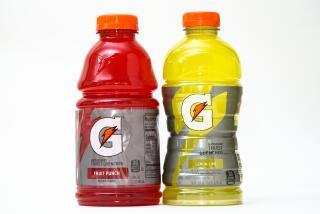No--Less Is Less! deck:
- Share via
They are on supermarket shelves dedicated to coffee, tea, soda pop, milk, cheese and cookies. But they are impostors. They are nondairy creamers, unsweetened sodas, decaffeinated coffees and low-fat cookies. They are, by grotesque irony, what they aren’t. They are the sum of their missing parts. As such, they should be called”nonundelows.”
Sure, nonundelows have their purposes. Not least of these is that selling depleted stuff has made food companies rich. Among themselves, technologists cannot quite suppress their glee. “Markets around the world are experimenting with inexpensive sugar substitutes--and not calling it diet,” crows a headline in the NutraSweet Co.’s in-house newsletter, Sweetener Digest.
The boon is that the no-calorie sweetener aspartame is much cheaper, lighter and more potent per pound than what the authors of the newsletter call “nutritive sweeteners.” In other words, unlike sweeteners capable of imparting energy, nonnutritive sweeteners have no food value.
In a superb sleight of hand, we have been led to believe that the leaching of those pesky “nutritive” elements from our food and drink is somehow good for us. And before dentists and the diet industry rise in indignant defense of sugar substitutes, it should be stressed that, with nonundelows, there is always some nannying medical or, more often, pseudo-medical defense. The rationale behind nonundelows is that their manufacturers are protecting us from excess by denying us content in the first place.
Take what happened to eggs. Scientists now acknowledge that the early concern about cholesterol content in egg yolks was grossly exaggerated, perhaps completely unfounded. However, the nonundelow industry has not backed down from the stance that egg substitutes, along with denatured and processed eggs, are somehow better for us than traditional fresh eggs.
Chain restaurants offering scrambled eggs now usually also offer “no-cholesterol” alternatives. Supermarket shelves carry desiccated approximations of eggs that even a starving astronaut might reject. Most nauseating are the jars of pasteurized egg whites that look like runny lumps of dirty snow. These are recommended for omelets.
Not only is there no culinary defense for yolk-free omelets, these abominations also have negligible nutritional value. The yolk contains the vast majority of the egg’s protein and vitamins.
The beauty of nonundelow eggs from the food processor’s point of view is that nutritious yolks can then be sold to manufacturers for use in cakes, pasta and sauces. Traditionally, the most classic of these sauces was mayonnaise.
But even this ground is slipping in the ever-warping world of nonundelows. The classic marriage of egg yolk and vegetable oil no longer requires egg yolk. A nonundelow “mayonnaise” might consist of water, canola oil, corn starch, malt vinegar, skim milk powder, whey protein and plenty of spices to make the mess taste of something. Of anything. Anything but mayonnaise.
It is not surprising to find milk powder in salad dressing. Powdering milk is a time-honored process. It predates mass refrigeration and it is good husbandry. Though wet milk lasts 14 days at 40 degrees, powdered lasts a year at 80 degrees.
So when we buy wet milk, we pay a premium. As we should; it’s a luxury. But when buying supposedly fresh low-fat milk in California, we are also being sold powdered. California’s dairy industry prides itself on its addition of powdered “milk solids” into fresh “low-fat,” “reduced-fat” and “nonfat” milks. This improves “mouthfeel” and boosts the protein and calcium content, industry representatives say.
This trick is not made plain on the label. But when the industry admits to it, it does so proudly. In corporate handouts, it refers to this adding of powder as the “California advantage.” Translated, this means that our enhanced skimmed milk is less vile than the un-enhanced skimmed minimum standard allowed by federal law.
But what happens to the cream from our skimmed milk? We’re sold this separately, at a premium. But even products where one might rightly expect to find cream--say, cream cheese--have fallen prey to the adulterators. Read the labels of America’s leading brand of “fat-free cream cheese” and, in addition to various sorts of skimmed milk, one finds two sorts of gum and a gelatinous seaweed added for thickening.
One could perhaps accept the success of nonundelows if they were cheaper than the foods they aspire to replace. But they rarely are. Decaffeinated coffee tends to cost more. (It must be all that sloshing around of the beans in solvents and water.) Sodas made with “nonnutritive sweeteners” cost the same as those made with the considerably more expensive corn syrup. Egg substitutes often cost the same or more than real things. Milk skimmed of the very fat that gives it flavor and body costs only a fraction less than whole milk.
And what of their supposed benefits? The idea behind nonundelows is that we can still enjoy our favorite foods, only more of them. Or that we can eat what we want without gaining weight.
But it isn’t working. Nonundelows are not the foods that we liked in the first place. They don’t taste as good.
The supposed health benefits of nonundelows have also proved elusive. America leads the world not only in consumption of nonundelows but also in obesity.
Yes, of course there are other factors in the fattening of America: We drive more and walk less, and so on. But my own guess is that we can’t stop eating because nonundelows leave us hungry.
More to Read
Eat your way across L.A.
Get our weekly Tasting Notes newsletter for reviews, news and more.
You may occasionally receive promotional content from the Los Angeles Times.








